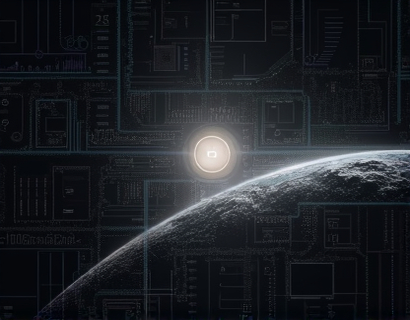Decentralized Innovation: Transforming Global Blockchain Ecosystems Through Comprehensive Collaboration Platforms
The advent of blockchain technology has ushered in a new era of decentralization, offering unprecedented opportunities for transparency, security, and efficiency in various industries. At the heart of this revolution lies the potential for decentralized innovation, driven by comprehensive collaboration platforms that enhance the capabilities of blockchain networks. This article delves into the transformative impact of such platforms, exploring how they are reshaping the global blockchain ecosystem through improved collaboration, innovation, and governance.
Blockchain technology, by its very nature, is decentralized, meaning that no single entity has control over the entire network. This decentralization, while a strength, also presents challenges in terms of coordination, scalability, and governance. Traditional blockchain projects often struggle with fragmented efforts, siloed development, and inefficient decision-making processes. To overcome these hurdles, a new generation of platforms is emerging, designed to foster comprehensive collaboration among developers, users, and stakeholders across the globe.
These collaboration platforms serve as central hubs where individuals and organizations can connect, share resources, and engage in collective decision-making. By providing a structured and accessible environment, they facilitate the exchange of ideas, accelerate the development of new applications, and enhance the overall resilience of decentralized networks. The following sections will explore the key features and benefits of these platforms, highlighting their role in driving innovation and efficiency within the blockchain ecosystem.
Enhanced Collaboration
One of the primary advantages of comprehensive collaboration platforms is the enhancement of collaboration among diverse participants. These platforms offer tools and features that streamline communication, project management, and resource sharing. For instance, integrated chat systems, forums, and video conferencing tools enable real-time interaction, breaking down geographical barriers and fostering a sense of community.
Moreover, these platforms often incorporate version control systems and collaborative coding environments, allowing developers to work together seamlessly on complex projects. By maintaining a single source of truth and ensuring that all changes are tracked and reversible, these tools reduce the risk of errors and conflicts, leading to more efficient and reliable development processes.
Another significant feature is the ability to create and manage decentralized teams. Platforms can facilitate the formation of cross-functional teams, bringing together experts from various domains such as development, design, and marketing. This diversity of expertise is crucial for addressing the multifaceted challenges of blockchain projects and for driving innovation through diverse perspectives and solutions.
Accelerated Innovation
Innovation is the lifeblood of the blockchain ecosystem, and comprehensive collaboration platforms play a pivotal role in accelerating this process. By providing a shared space for idea generation and prototyping, these platforms enable rapid experimentation and iteration. Developers can quickly test new concepts, gather feedback, and refine their approaches, significantly reducing the time-to-market for new applications and services.
Furthermore, these platforms often feature open innovation models, where contributions from the community are welcomed and integrated into the project. This inclusive approach not only broadens the pool of ideas but also builds a stronger, more resilient ecosystem. Contributors feel valued and motivated, leading to higher engagement and more robust contributions.
To further stimulate innovation, many platforms host hackathons, challenges, and competitions. These events bring together talented individuals to solve specific problems or develop novel solutions, fostering a culture of creativity and competition. The best projects from these events can then be integrated into the main platform, ensuring that innovative ideas are not only recognized but also implemented.
Robust Governance
Effective governance is essential for the sustainable growth and success of decentralized networks. Comprehensive collaboration platforms address this need by implementing transparent and participatory governance models. These models empower the community to have a say in the direction and development of the platform, ensuring that decisions reflect the collective interests of all stakeholders.
One key aspect of governance on these platforms is the use of decentralized autonomous organizations (DAOs). DAOs enable the creation of self-governing entities where decisions are made through smart contracts and community voting. This approach eliminates the need for centralized authorities, reducing the risk of bias and corruption. Instead, governance is distributed among token holders or community members, promoting fairness and accountability.
Transparency is another cornerstone of governance on these platforms. All proposals, discussions, and voting results are recorded on the blockchain, providing an immutable and verifiable history. This transparency builds trust among users and stakeholders, as they can easily track the decision-making process and hold the community accountable.
Additionally, these platforms often implement modular governance structures, allowing for flexibility and adaptability. As the ecosystem evolves, governance models can be adjusted to address new challenges and opportunities, ensuring that the platform remains relevant and effective over time.
Scalability and Efficiency
Scalability and efficiency are critical factors for the widespread adoption of blockchain technology. Comprehensive collaboration platforms are designed to enhance these aspects, enabling decentralized networks to handle increasing amounts of data and transactions without compromising performance.
One way these platforms achieve scalability is by optimizing the underlying blockchain infrastructure. They may integrate layer 2 solutions, such as sidechains and state channels, to offload some of the processing load from the main chain. This not only improves transaction throughput but also reduces costs and latency, making the network more accessible and user-friendly.
Moreover, collaboration platforms can leverage the collective computing power of the community to enhance network security and resilience. By distributing tasks and resources across a wide network of nodes, these platforms reduce the risk of single points of failure and increase overall system robustness.
Efficiency is also improved through standardized protocols and interoperability standards. These platforms can facilitate seamless interactions between different blockchain networks, enabling the creation of a more interconnected and cohesive ecosystem. By breaking down silos and promoting compatibility, these platforms pave the way for more complex and powerful decentralized applications.
Case Studies and Real-World Applications
To better understand the impact of comprehensive collaboration platforms, let's examine a few real-world examples. One notable instance is a decentralized finance (DeFi) project that utilized a collaboration platform to develop a new lending protocol. By bringing together developers, economists, and users, the project was able to design a robust and user-friendly system that addressed several pain points in traditional lending models.
The platform's collaborative tools enabled the team to iterate quickly, incorporating feedback from the community at each stage. The result was a protocol that not only gained widespread adoption but also attracted significant investment, demonstrating the power of collective innovation.
Another example is a supply chain management solution built on a collaboration platform. This project involved multiple stakeholders, including manufacturers, distributors, and retailers. By using the platform to coordinate efforts and share data, the consortium was able to create a transparent and efficient system that reduced delays and costs. The immutable record-keeping provided by the blockchain ensured traceability and accountability, enhancing trust among all parties.
Future Prospects
The future of decentralized innovation through comprehensive collaboration platforms is promising. As more projects adopt these platforms, we can expect to see a surge in the development of more sophisticated and interconnected blockchain applications. The integration of advanced technologies such as artificial intelligence and the Internet of Things (IoT) with decentralized networks will further expand the possibilities, leading to more intelligent and autonomous systems.
Moreover, the growing awareness and adoption of decentralized governance models will empower communities to take greater control over their digital assets and services. This shift towards community-driven governance will not only enhance the resilience of blockchain ecosystems but also democratize access to technology, making it more inclusive and equitable.
In conclusion, comprehensive collaboration platforms are revolutionizing the global blockchain ecosystem by fostering enhanced collaboration, driving innovation, and improving governance. These platforms provide a fertile ground for developers and users to come together, share resources, and shape the future of decentralized networks. As the ecosystem continues to evolve, the role of these platforms will become increasingly vital, paving the way for a more connected, efficient, and resilient blockchain world.











































